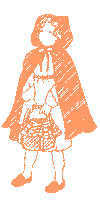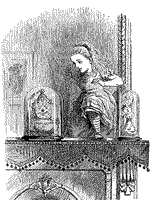 |
 |
Linguistic indicators of point of view
Our answer for task B
We feel closest to, and most involved with, the opening from Through
the Looking Glass. Now let's explore why.
 The
Little Red Riding Hood beginning, like most folktale beginnings,
assumes that the characters and events are new to us, and introduces them
to us as new information. The 'once upon a time' opening is indicative
of this, but a more important feature is the use of indefinite reference
for things when they are referred to for the first time in the story.
The most obvious examples of this are the use of the indefinite article,
'a', at the beginning of the noun phrases 'a sweet little girl' and 'a
red velvet cap'. The indefinite numeral 'one' in 'one day' has a similar
effect. Once something has been introduced in this way, definite reference
can be used (cf. 'she' and 'the little girl'),of course, and some other
uses of definite reference are related to our schematic assumptions about
the nature of the world. For example, we assume that most small girls
will have grandmothers, and so definite reference is used when Little
Red Riding Hood's grandmother is introduced in the first sentence. The
Little Red Riding Hood beginning, like most folktale beginnings,
assumes that the characters and events are new to us, and introduces them
to us as new information. The 'once upon a time' opening is indicative
of this, but a more important feature is the use of indefinite reference
for things when they are referred to for the first time in the story.
The most obvious examples of this are the use of the indefinite article,
'a', at the beginning of the noun phrases 'a sweet little girl' and 'a
red velvet cap'. The indefinite numeral 'one' in 'one day' has a similar
effect. Once something has been introduced in this way, definite reference
can be used (cf. 'she' and 'the little girl'),of course, and some other
uses of definite reference are related to our schematic assumptions about
the nature of the world. For example, we assume that most small girls
will have grandmothers, and so definite reference is used when Little
Red Riding Hood's grandmother is introduced in the first sentence.
 The
opening of Through the Looking Glass, on the other hand, seems
to be assuming that we already know about the white kitten and the black
kitten, even though this cannot be true. These are the first two sentences
of the story. This effect comes about because of the initial use of definite
reference, in the form of the anaphoric pronoun 'it' (which apparently
refers back to some unspecified circumstance it is assumed we already
know about), and the definite article 'the' in the noun phrases 'the white
kitten', 'the black kitten' and 'the last quarter of an hour'. We appear
to know already (even though we can't really) which kittens are being
referred to, and we appear to be situated in the same time-frame as the
person who is trying to work out which kitten is responsible for whatever
has happened. The
opening of Through the Looking Glass, on the other hand, seems
to be assuming that we already know about the white kitten and the black
kitten, even though this cannot be true. These are the first two sentences
of the story. This effect comes about because of the initial use of definite
reference, in the form of the anaphoric pronoun 'it' (which apparently
refers back to some unspecified circumstance it is assumed we already
know about), and the definite article 'the' in the noun phrases 'the white
kitten', 'the black kitten' and 'the last quarter of an hour'. We appear
to know already (even though we can't really) which kittens are being
referred to, and we appear to be situated in the same time-frame as the
person who is trying to work out which kitten is responsible for whatever
has happened.
In the opening to Through the Looking Glass, then, we are presented
with the information we are given not as new, but as given. As a consequence,
we feel more involved, more 'close up' (we have a 'worm's eye view') and
feel that we have come into the story 'in the middle of things' (or in
medias res if we use the Latin term often used for this concept). If
indefinite reference is used, as in the Little Read Riding Hood
example, our viewpoint is not close up (sometimes called a 'worm's eye'
view) but feels much more distant (a 'bird's eye' view).
Note how readers 'put themselves in the viewing position ' created for
them by the text. In these texts, it is the presentation of information
as given or new which is making the main difference in our felt relationship
with what is described.
|

